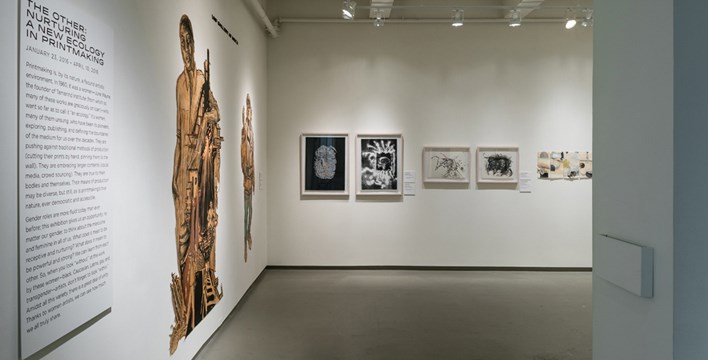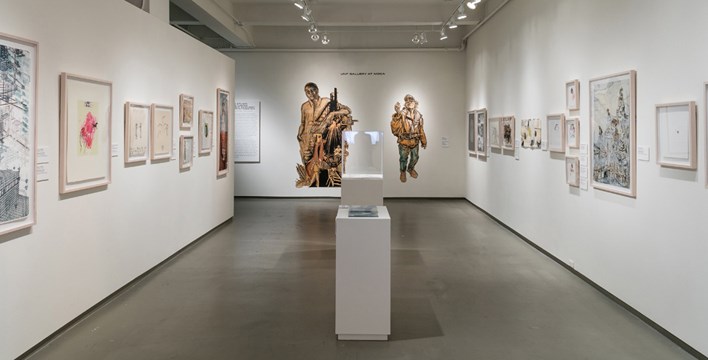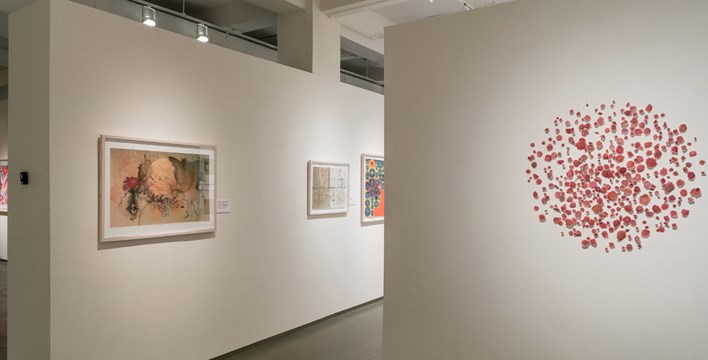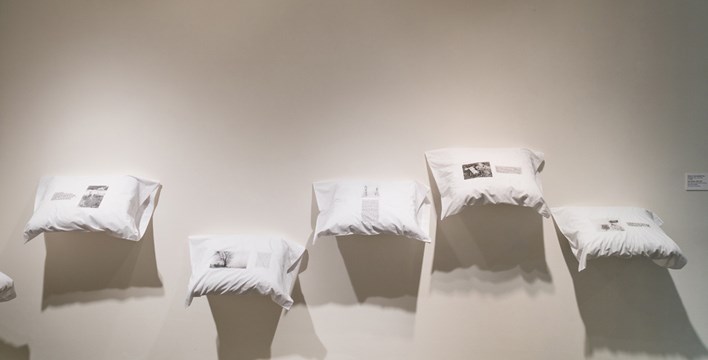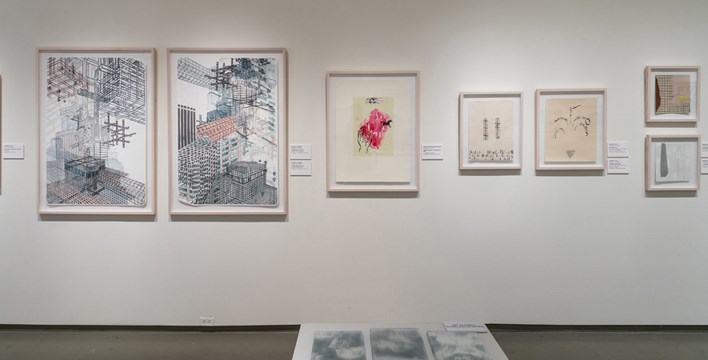THE OTHER: NURTURING A NEW ECOLOGY IN PRINTMAKING
JANUARY 23, 2016 - APRIL 10, 2016
Printmaking is, by its nature, a fecund artistic environment. In 1960, it was a woman-June Wayne, the founder of Tamarind Institute (from which so many of these works are graciously on loan)-who went so far as to call it “an ecology.” Women, many of them unsung, have been printmaking pioneers, exploring, publishing, and defining the boundaries of the medium over the decades. They push against traditional methods of production (cutting their prints by hand; pinning them to the wall). They embrace larger contents (social media, crowdsourcing). They are true to their bodies and themselves. Their means of production may be diverse, but still, as is printmaking's true nature, ever democratic and accessible.
Gender roles are more fluid today than ever before; this exhibition provides an opportunity, no matter our gender, to think about the masculine and feminine in all of us. What does it mean to be receptive and nurturing? What does it mean to be powerful and strong? We can learn from each other. When you look “without” at the work by these artists-emergent/established; Caucasian/Latina/African-American; homo/hetero/trans-don't forget to look “within.” Amidst all this variety-there is a great deal of unity. Thanks to these women, we can see how much we all share.
ARTISTS

TAYLOR BISANZIO
Taylor Bisanzio is a working artist in New York who specializes in both digital design and traditional art. Combining her past studies in animation with her interest in printmaking, she employs both mediums to push the world of printmaking further. Exploring the dark sides of the psyche, Bisanzio juxtaposes the intensity of the subject with the aesthetic beauty of her moving prints.

SUZANNE CAPORAEL
Painter and printmaker Suzanne Caporael depicts the physical world, from the periodic table to tree rings, elements of pigments, estuaries, melting ice, and plant stems. Caporael begins by studying the subject and examining the relationships between its elements. After her data collection is complete, she transforms it into compositions of irregular shapes, lines, and blots that at times mimic nature.

KATE COLLYER
New York-based printmaker Kate Collyer's goal is to create individual prints that are also collaborative and interactive to provide viewers with a sense of existence in her constructed environments. Collyer's subjects are often landscapes, where she highlights the natural beauty and at the same time, references its boundaries. Her process combines printmaking techniques with materials including fused glass and sandstone.

AMY CUTLER
Amy Cutler is an internationally acclaimed artist best known for her illustrations of women performing strange, cryptic tasks such as carrying goats on their backs. Cutler's style is simple and reminiscent of European folk art. The nonlinear narratives of her figures' journeys unravel upon the white backgrounds of her drawings. Cutler's fantasy world is both humorous and ominous.

ELAINE DE KOONING
Elaine de Kooning was an innovative painter, writer, and teacher from Brooklyn, New York. She was largely known for her work in Abstract Expressionism, and her subjects range from mythology to landscapes and portraiture. She worked in a range of modes from realism to abstraction to avoid developing a single style. Her travels often led to her inspiration for a piece, such as when she ventured to Mexico in the late 1950s and saw her first bullfight, a trip that inspired a series of bull paintings.

LESLEY DILL
American artist Lesley Dill works in many different mediums, where she combines text and the human form. Her works are often inspired by poetry from Emily Dickinson, Franz Kafka, Salvador Espriu, Tom Sleigh, and others. Her various interests and combinations result in a variety of figural and layered imagery. In her early works, her figures are fairly literal, yet she adds poetry to create multilayered images rich with meaning. At times, Dill pushes the use of the figure to extremes-disembodied heads, hands, and dresses intertwined with words and phrases populate her compositions.

SHEILA GOLOBOROTKO
Brazilian artist Sheila Goloborotko is the founder and director of Goloborotko's Studio, a printmaking studio and workshop in Brooklyn, New York. Her work uses familiar objects, including pillows, and gives them new meaning by printing on them. She makes many one-of-a-kind prints that are made up of many layers of different media, including ink, chine-colle, and color viscosity.
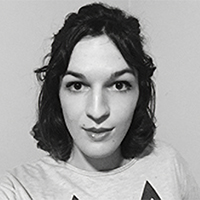
CATHERINE GRAFFAM
Transgender artist Catherine Graffam is a painter and printmaker whose work often explores personal identity and interpersonal relationships. For Graffam, her work is an opportunity to visualize how it feels to be a transgender woman in all facets of life.
Image courtesy of the Artist.

KAREN KUNC
Printmaker Karen Kunc, who lives and works in Nebraska, is primarily known for her color woodcut prints. Her works are largely influenced by Japanese woodblock prints and the work of the German Expressionists. Kunc gains inspiration from forces of nature such as weather, migration, and erosion. For Kunc, a print's layers offer viewers an opportunity to examine its expressionism and innovative printmaking techniques.
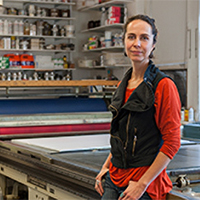
NICOLA LÓPEZ
American artist Nicola López specializes in printmaking, drawing, and installation. She uses cartography to exaggerate and reconfigure urban landscapes. Her focus on describing “place” comes from an interest in urban planning, architecture, and anthropology, and is fueled by time spent working and traveling in different landscapes.
Portrait of the artist. Photo Credit: Joel Jares.

TARYN MCMAHON
Printmaker Taryn McMahon, who lives and works in Kent, Ohio, constructs installations out of prints and Mylar that blend natural and manmade structures. Her work uses images of patterns found in nature to study sites and histories, bringing to light how complicated the construction of “nature” really is. The finished installations correlate to the architecture of their sites in hopes of changing how viewers move through the space.

JILL PARISI
Guided by her imagination, Jill Parisi's work reveals a fictitious plant and animal ecosystem. She reconfigures colors, patterns, and structures from a variety of species and places by using materials such as translucent tissue-weight papers and glass. While using printmaking techniques including hand-color application, drawing, and hand-cut components, she allows viewers to see the intricate craftsmanship of all the different layers in a print.
Image courtesy of the artist.

JUDY PFAFF
Judy Pfaff is known primarily for her two- and three-dimensional prints and large-scale installations. Her prints possess a fluid quality, where she incorporates multiple circles, lines, and organic shapes throughout each image. At times, such shapes are completed with hand-applied paints, fabric dyes, and multiple layering.

LILIANA PORTER
Liliana Porter works on canvas, prints, drawings, collages, and small installations, in which she depicts figurines, knickknacks, toys, and souvenirs from places such as flea markets and antique stores. The objects are often placed in monochromatic empty backgrounds. Porter says these objects have two purposes: to highlight their intended function and allow viewers to give them new meaning through the way she photographs them, attaches them, or uses them as subjects for prints and etchings.

JAUNE QUICK-TO-SEE SMITH
Jaune Quick-to-See Smith is a Native American artist of French-Cree, Shoshone, and Salish blood, who lives and works in Albuquerque, New Mexico. Her paintings and prints often explore the destruction of the environment and governmental oppression of native cultures. She combines representational and abstract images inspired by artists such as Pablo Picasso, Paul Klee, and Robert Rauschenberg, as well as traditional Native American art.

ALISON SAAR
Los Angeles-based sculptor and painter Alison Saar often uses the nude female and themes of African dispersion and femininity. African and Afro-American art are also referenced in her work as she combines urban and contemporary themes with folklore and mythology.

KIKI SMITH
Kiki Smith, an American artist who lives and works in New York City, is primarily known for sculpting and printmaking. Her work focuses on a range of subjects, from anatomy and nature, to themes of life, death, and resurrection, influenced by her Catholic upbringing.

TANJA SOFTIĆ
Bosnian-born Tanja Softić, who lives and works in Richmond, Virginia, focuses on exploring memory. She is interested in the process of how the mind is expanded when a viewer sees events or objects in imaginary architectural settings. Softić often combines botanical and anatomical drawings and also incorporates historical references in her work. The multilayered images reflect the landscapes of both memory and the contemporary living experience.

JILLIAN SOKSO
Printmaker Jillian Contreni Sokso is influenced by biographical history, especially her immediate surroundings she uses to create connections between humankind and the natural world. Her work often combines printmaking techniques such as intaglio, lithography, and screen-printing with digital imagery.
Photo credit: Jeremy Lloyd
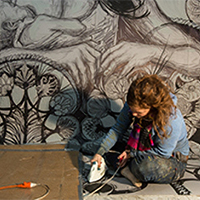
SWOON
American artist Swoon is well known for her large-scale, site-specific street art. Part portraiture, part prints, her work explores the relationship between people and their built environments. She often affixes intricate paper-cut portraits and cityscapes to walls in impoverished places where the work will eventually disintegrate in place. Swoon creates the prints at home, where she carves the lino-blocks and presses the images into paper by walking on them with bare feet.
Photo by Swen Rudolf.
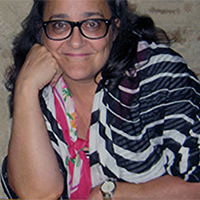
SHELLEY THORSTENSEN
Printmaker Shelley Thorstensen operates Printmakers Open Forum, a printmaking studio and workshop in Oxford, Pennsylvania. While hand-pulled, color multi-print media is her specialty, she has expertise in all printmaking techniques and combines them in layered, colorful prints. Thorstensen is interested in pairing traditional printmaking techniques with modern, digital styles and proposes that medium can comprise a significant part of an artwork's meaning. She states that color and form can be separate investigations into meaning where they are unlinked and either can assume a dominant role that is not determined until she determines a print is complete.
Image courtesy of the Artist.

MARIE WATT
Marie Watt is well known for her fabric work, as she uses blankets to be both material and metaphorical. Her works examine the social and cultural history rooted in everyday objects. A blanket, for example, is used for many things, such as comfort, decoration, and warmth, and is always there. Watt uses her work to show the sentimental value that embedded in these objects.

JUNE WAYNE
June Wayne was a master printmaker and self-taught painter, who strived to revive fine-art lithography in the twentieth century. In doing so, she founded the Tamarind Lithography Workshop, a place for artists and printers to learn and help ensure the survival of the technique. Wayne's work illustrates her in-depth knowledge of lithography and its potential for further exploration of the process.
SPONSORS
SUPPORTING
Judy Eisen, Scottie and Winfield Gartner, Todd Sack and Barbara Sharp

